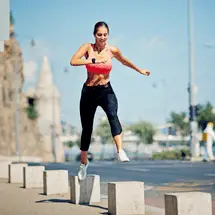The best balance and stability exercises can improve running performance and prevent accidents and injuries. When your body and brain are trained for steadiness in motion, the impact of your foot strikes is absorbed more efficiently, reducing overuse injury risk and boosting the ability to restore your balance without a fall if you trip.
If you’re a runner then you’re probably interested in ways to improve your running and reduce your risk of injury. Our article tells you more about the role balance and stabilization exercises can play in both boosting performance for runners and steering them away from painful accidents and physical dysfunctions.
Benefits of balance and stabilization for runners
In every field of life and sport, good posture and balance control are fundamental to carrying out movements or motor tasks safely and efficiently. Efficient postural balance and proprioception reduce fall risk and optimize athletic performance. This is particularly true for runners but often neglected in favor of training focused on speed or endurance.
Balance is the word we use to describe the process of maintaining our physical center of gravity vertically above our base (legs). Balance relies on both our bodies and brains, with rapid and continuous feedback between them being essential for smooth, accurate, and coordinated movement.
Proprioception, our internal sense of positioning and motion, is also essential for our overall stability and is closely interrelated with static and dynamic balance. Specialized nerves in joints, muscles, ligaments, and tendons help to sense the body’s position and movement, enabling us to stand or move with our eyes closed or while focused on something else.
If the proprioceptive neural pathways aren’t challenged often enough, the efficiency of our specialized proprioceptive nerves may decrease, especially as we age. This affects the precision of athletic movement, leading to poorer biomechanics and the raised potential for overuse injuries. Previous injuries can also negatively impact proprioception through damage to the special nerve endings.
Runners without strong senses of balance and proprioception are more likely to experience overuse injuries, falls, and related accidents.
Related: Are you overtraining? Signs You Shouldn’t Ignore!
Overall muscles targeted for balance and stabilization exercises for runners
When building balance and stability in runners, it’s important to focus on the core muscles from the start. In this context, that means any muscle that influences the position of the pelvis, hip, and lumbar spine during functional movements, including:
- Erector spinae
- Rectus abdominis
- Internal and external obliques
- Transverse abdominis
- Multifidus
Without a strong core, other parts of the body can become destabilized in motion, especially under exertion. A strong core is a base on which runners can really build the strength and stability of leg muscles, especially around the ankle and knee.
Hamstrings, quads, and calf muscles are all obviously important for balance and stability in runners. The muscles in the foot and ankles can also play a valuable role and attention should be paid to training muscles in the full leg and foot.
Related: Why Are Core Muscles Important To Runners?
How often (per week) should you perform balance and stabilization exercises for runners?
You may want to practice balance and stabilization training at least twice each week. Research analysis suggests that an efficient balance and stability training program should initially last for 8 weeks, with two training sessions of 45 minutes each week.
Discuss exercise intensity and frequency with your doctor, physiotherapist or coach, if you are actively seeking to address or prevent injury, or to boost your performance.
What is the easiest balance and stabilization exercise to do?
The easiest balance and stabilization exercise is probably simply standing on one leg for as long as you can, increasing the difficulty of the challenge by closing your eyes and adding movement or surface change.
- Begin by simply standing on one leg for as long as you can without any support. You can make this easier by keeping your foot low, or harder by raising your knee up to your chest. If you can only balance for less than 30 seconds, continue to practice this first stage to build up your time.
- The next stage is to balance on one leg with your eyes closed, again for as long as you can manage. If you can’t last for more than 30 seconds, keep practicing.
- A further challenge is to stand on one leg with eyes closed and try to tilt your head backward or turn it side to side without losing your balance. Similarly, try moving your arms in circles or back and forth. Time yourself and see how long you can balance while moving your head or arms, pushing yourself to last longer each time.
- The difficulty can be ratcheted up yet another level by standing on a less stable surface such as a pillow or folded blanket rather than a flat floor. Again, attempt this with closed eyes, while moving your head, etc.. and aim to build up your balancing time.
The best balance and stabilization exercises for runners
There are many exercises that effectively improve static and dynamic balance and stabilization for runners. We’ve gathered a selection of the best for you to try.
Hip swings
Difficulty: easy
Muscles targeted during exercise: glutes, hip flexors, abdominals
- Stand on one leg with your foot on a flat, stable surface.
- Bend your other knee slightly and swing your leg forward and backward in a controlled movement while remaining upright.
- Do 10 reps on each side, pausing the movement for 1 second at each end.
Increase the challenge by closing your eyes or standing on a cushion or other less stable surface.
Single leg Russian deadlift
Difficulty: medium
Muscles targeted during exercise: hamstrings, glutes, ankles, core
- Standing straight on one leg, bend the body forward slowly from the hip of your weight-bearing leg.
- Raise the other leg behind you in line with the downward bend of your torso, being careful not to round your back.
- Repeat the exercise 8-15 times on each side.
Increase the challenge by closing your eyes, standing on a less stable surface, or adding weights.
Related: Best Ankle Braces For Running With Peroneal Tendonitis
Side lunges
Difficulty: easy
Muscles targeted during exercise: glutes, hamstrings, quads, adductors
- Begin standing straight, with feet together facing forward, and hands-on-hips.
- Step out to one side with the foot pointing forward and bend that knee to lunge (NB the knee should not go over your toes)
- Step back to the starting position and repeat on the other side.
- Do 10-15 reps on each side.
Increase the challenge by building up the number of reps or holding the lunge position for a second or two.
Glute bridges
Difficulty: easy-medium
Muscles targeted during exercise: glutes, hamstrings, calves, abdominals
- Begin lying on your back with feet flat on the floor and arms beside you.
- Lift your hips steadily towards the ceiling, keeping your shoulders on the floor and making a straight line between your shoulders, knees, and hips.
- Hold this position for two seconds and lower back down to the floor.
- Repeat 15-30 times.
Increase the challenge by stretching your arms out above your head, increasing the time you hold the pose, or increasing the number of repetitions.
Press and plank
Difficulty: medium-hard
Muscles targeted during exercise: oblique abdominals, glutes, shoulder stabilizer muscles
- Begin on the ground in a modified side plank with knees bent and forearm on the ground perpendicular to your trunk.
- Lift your hips to straighten your body from knees to shoulders.
- Raise your free arm straight up to the ceiling, before returning your whole body to the starting position.
- Do 10-15 reps on each side.
Increase the challenge by adding weight in your non-supporting hand for the press, performing in full side plank, increasing the number of reps or performing the exercise with eyes closed.
Single leg bound
Difficulty: hard
Muscles targeted during exercise: quads, calves, glutes, and hamstrings.
- Start by balancing on one leg.
- Jump upwards and forwards from your balance as far as possible.
- Land on the same foot, keeping knees straight ahead and pelvis level, jumping again as soon as you land.
- Continue this motion for as many repetitions as you can maintain good form.
- Switch legs and repeat on the other side.
Increase speed and number of repetitions as your competence and confidence rise.
Related: Best Bodyweight Glute Exercises For Runners To Prevent Injury
Conclusion
Balance and stabilization exercises are a good idea for many runners and can be worked into a twice-weekly routine that will help you to keep running smoothly and safely for years to come.
| Help support me and subscribe to my YouTube channel. YouTube video - 30 ways to make your runs less painful! Coach Scott's Credentials:
|
To sign up for a FREE half marathon training schedule, log sheet, and pace predictor CLICK HERE.

Recommended gear for runners
Connect with me:
| facebook.com/BeginnerToFinisher/ |
References


1 thought on “Best Balance And Stabilization Exercises For Runners”